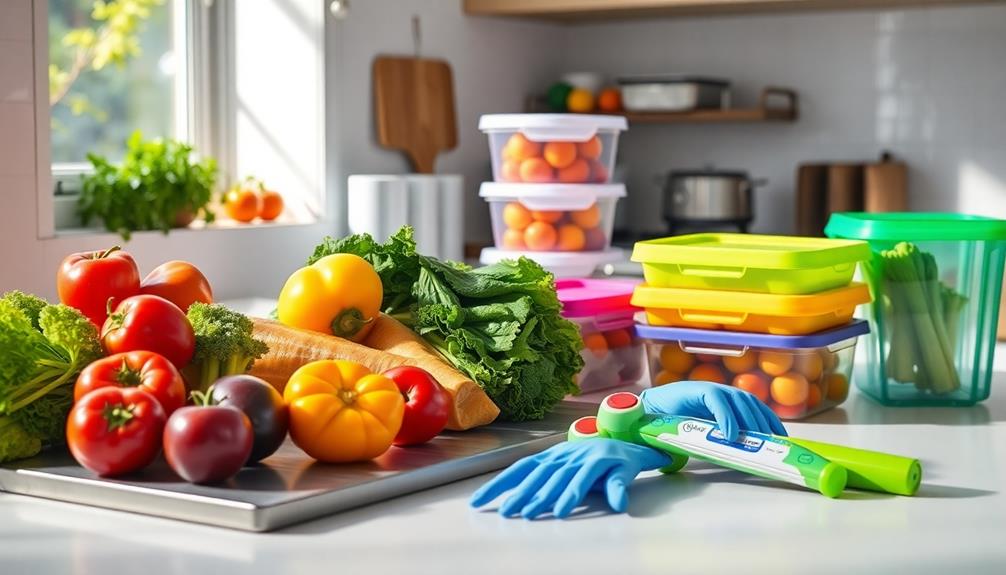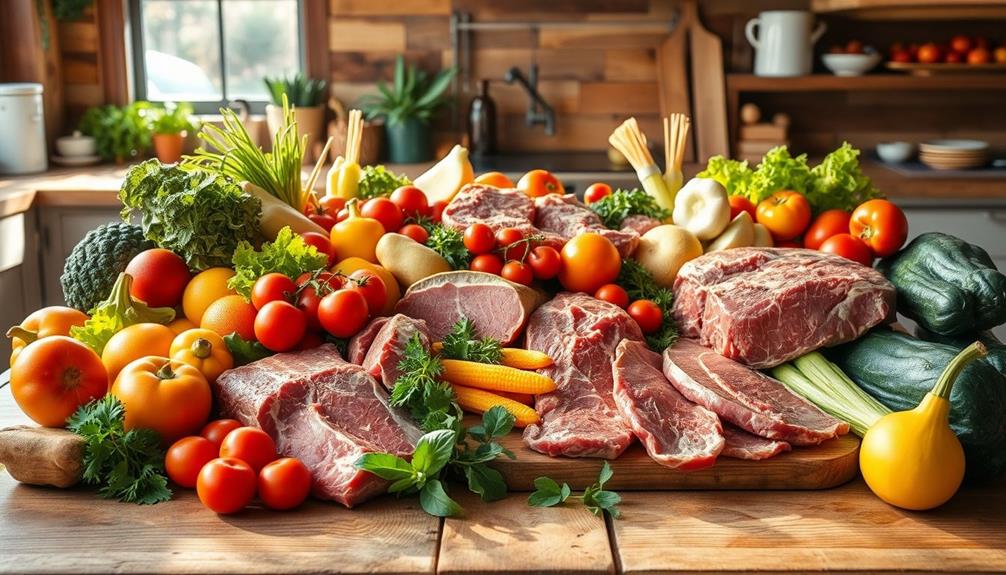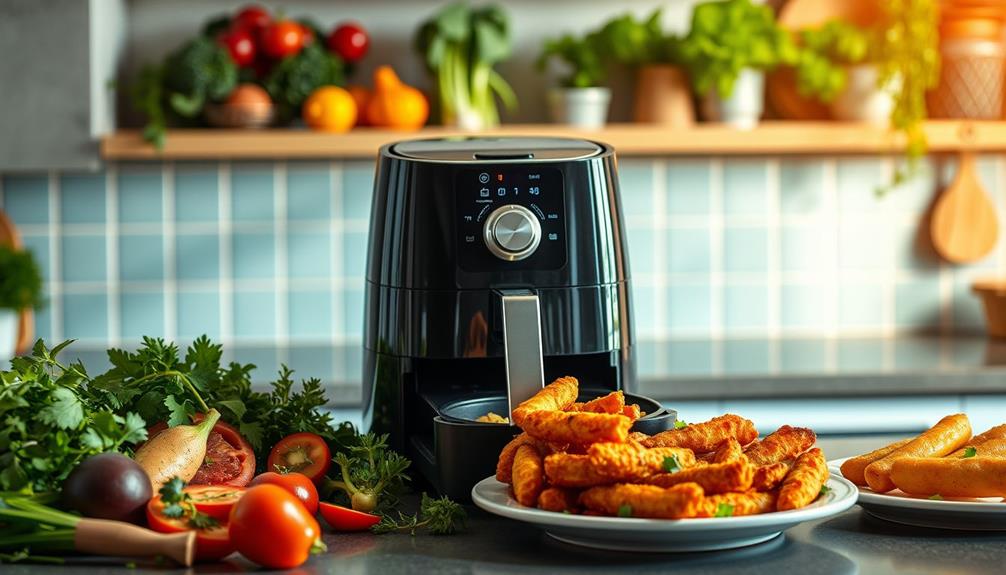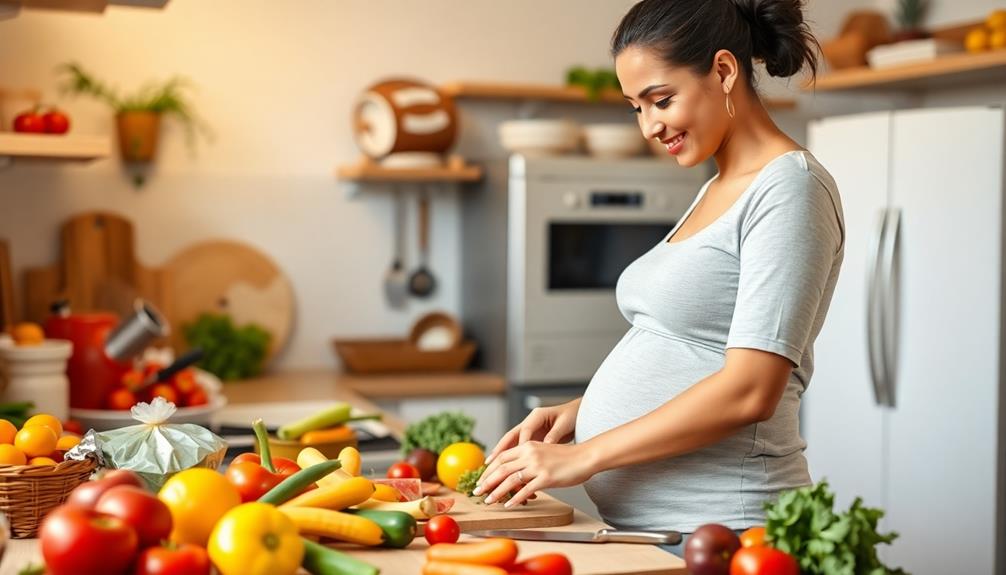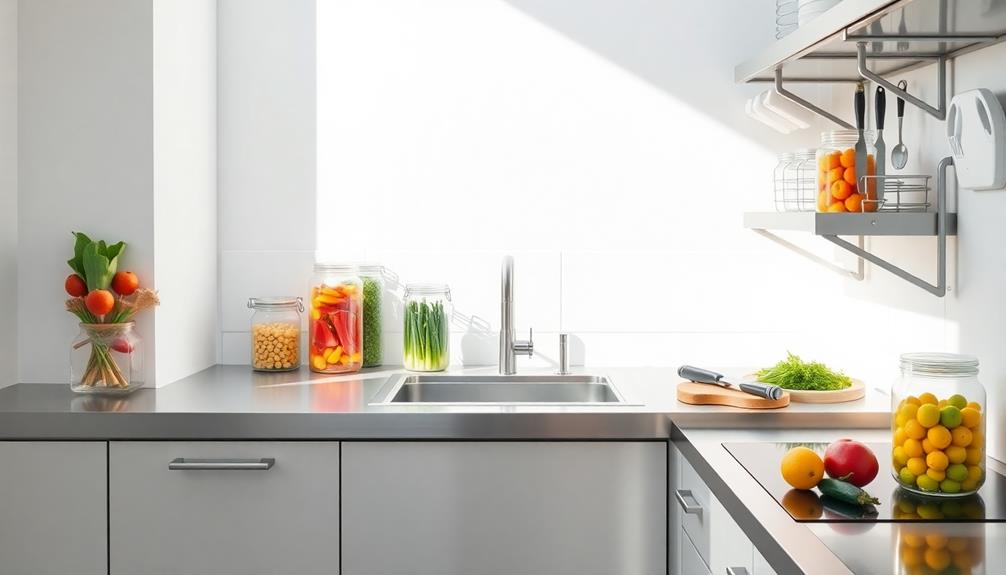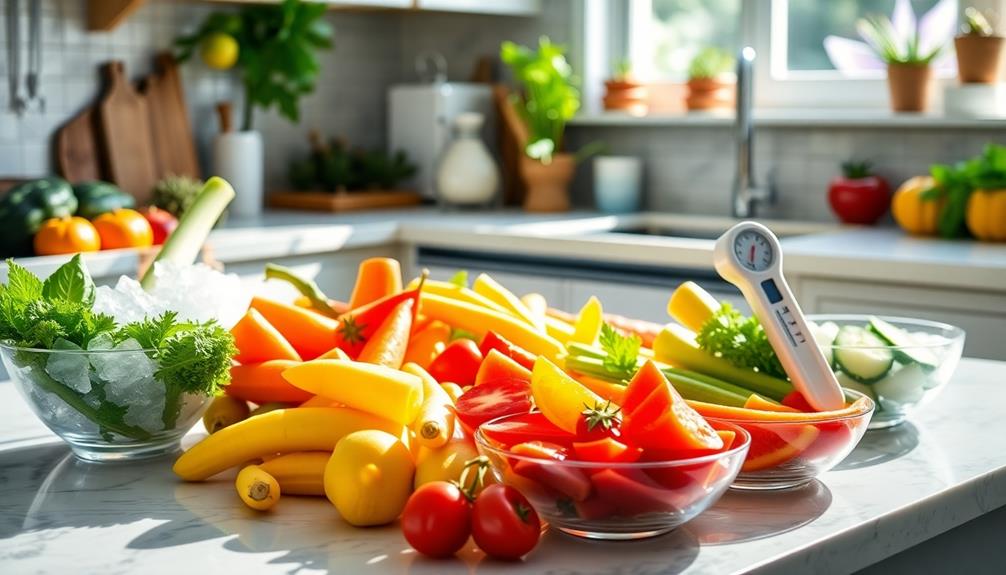To guarantee food safety with raw ingredients, you need the right equipment and practices. Start with high-quality tools like blenders and food processors for efficient prep. Use separate utensils and cutting boards for raw and cooked foods to avoid cross-contamination. Always wash your hands thoroughly after handling raw ingredients, and store raw meats on the bottom shelf of your fridge. Choosing fresh, non-GMO ingredients from reputable sources is essential. Keep an eye on quality and safety standards in manufacturing. There's a lot more to discover about raw food safety gear and practices that'll keep both you and your pets healthy.
Key Takeaways
- Maintain a clean and organized kitchen to prevent foodborne illnesses from bacteria like Salmonella and E. coli.
- Use high-quality food processing tools like blenders and food processors for safe and efficient raw food preparation.
- Implement strict safety protocols, including regular inspections and batch production, to ensure food quality and safety.
- Avoid cross-contamination by using separate utensils and cutting boards for raw and cooked foods, and wash hands thoroughly after handling raw meat.
- Source ingredients from USDA-inspected farms with humane practices, ensuring they meet AAFCO standards for balanced nutrition.
Importance of Raw Food Safety
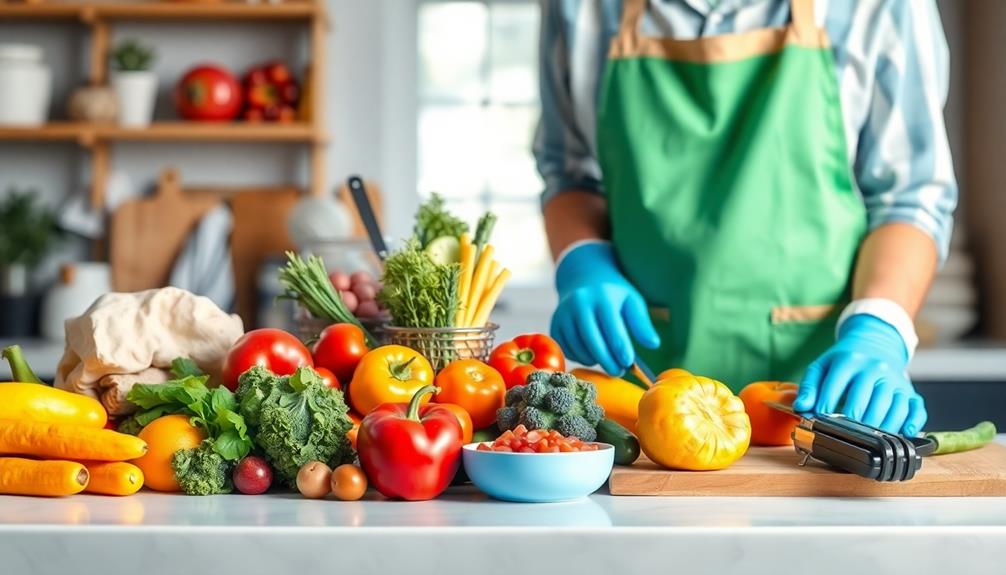
Raw food safety is absolutely fundamental for preventing foodborne illnesses that can affect both you and your pets. When you handle raw ingredients like meat, you must be aware of bacteria such as Salmonella and E. coli. These pathogens pose a significant risk if you don't practice safe food handling techniques.
To minimize cross-contamination, always use separate utensils and cutting boards for raw and cooked foods. This simple step can drastically reduce the chances of spreading harmful bacteria.
It's also essential to store raw meat at safe temperatures, ideally in the refrigerator or freezer, to limit bacterial growth.
After handling raw ingredients, make it a habit to clean all surfaces, tools, and pet food bowls thoroughly. Regular cleaning not only prevents the spread of pathogens but also creates a hygienic environment for both you and your pets.
Education on safe food handling practices is critical. Utilize resources from trusted sources like the FDA to guide you through the best practices.
Essential Equipment for Raw Food

Investing in the right equipment can make a significant difference in your raw food preparation. High-speed blenders, like the Vitamix 5200, are essential for creating smooth blends and sauces that elevate your raw foods. With a 10-year warranty, you can rely on their durability while whipping up nutritious meals.
Masticating juicers, such as the Omega VRT, operate at lower RPMs, making them ideal for raw food enthusiasts. They preserve nutrients and produce denser juice, ensuring you get the most out of your ingredients.
Quality food processors, like the Cuisinart 14-Cup model, help you efficiently prepare larger batches of raw meals, delivering consistent results every time.
Don't forget about dehydrators, particularly models like the Excalibur, which evenly distribute heat to preserve fruits and vegetables while maintaining their nutritional value.
Specialty equipment, including stone grinders for nut butters and raw chocolate, enhances texture and flavor, rounding out your raw food experience. By equipping yourself with these essential tools, you'll set yourself up for success in creating delicious, nutritious raw foods.
Safe Handling Practices for Raw Food

Maintaining a clean and organized kitchen is vital when handling raw food. To guarantee food safety, always use separate utensils and cutting boards for raw and cooked items. This practice helps prevent cross-contamination, which can lead to foodborne illnesses.
If you have any uneaten raw food, don't return it to the refrigerator; discard it to avoid bacterial growth.
After you handle raw food, wash your hands thoroughly to minimize the risk of transferring harmful bacteria to other surfaces or foods. It's also important to clean pet food bowls and any surfaces that come into contact with raw food regularly. This reduces the risk of spreading bacteria, especially in homes with pets or young children.
Make it a habit to promptly clean up any spills on the floor. This not only prevents accidental ingestion but also keeps your kitchen safe from contamination.
Quality Sourcing for Ingredients
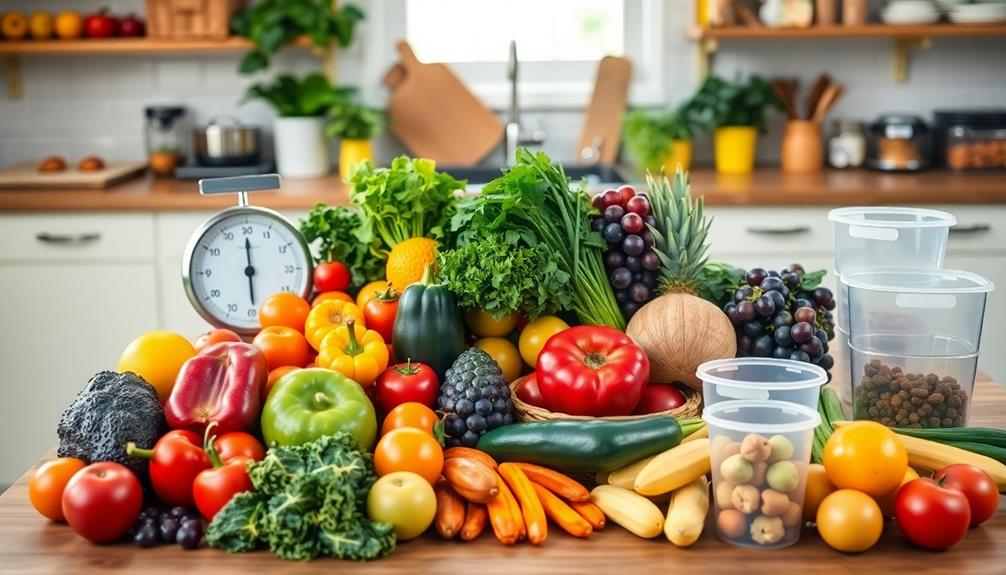
When it comes to feeding your pet raw food, quality sourcing is key.
You'll want to guarantee that ingredients come from USDA-inspected farms that prioritize humane treatment and sustainable practices.
Sourcing Standards and Practices
Quality sourcing for raw pet food ingredients is fundamental for guaranteeing your pet's health and well-being. By adhering to rigorous sourcing standards, you can assure that your furry friend receives the best nutrition possible. This is particularly significant when reflecting on best dog food for allergies, as high-quality ingredients can play an essential role in managing sensitivities.
Here are three key aspects to bear in mind when sourcing your pet's food:
- USDA-Inspected Farms: Choose ingredients sourced from USDA-inspected farms where animals are treated humanely and quality standards are strictly followed.
- Sustainable Practices: Look for pasture-raised poultry, grass-fed beef, and sustainably sourced wild-caught fish. These choices not only enhance nutritional value but also promote environmental responsibility.
- Non-GMO and Pesticide-Free: Verify that fruits and vegetables in your pet's diet are non-GMO and pesticide-free. This helps maintain safety and health for your pet, free from harmful chemicals.
Regular farm visits are essential to verify that these sourcing standards are upheld, guaranteeing the integrity of the ingredients.
Additionally, all ingredients should meet AAFCO standards for complete and balanced nutrition, providing your pet with the necessary nutrients they need for a healthy life.
Ingredient Quality Assurance
Ensuring ingredient quality is essential for providing your pet with a nutritious raw food diet. To achieve this, you need to focus on ingredient quality assurance.
Start by sourcing high-quality food products, like pasture-raised poultry and grass-fed beef, which guarantee humane treatment of animals and sustainable practices. When it comes to fish, choose sustainably sourced, wild-caught varieties that support a responsible supply chain.
In addition to protein sources, the fruits and vegetables in your pet's diet should be non-GMO and pesticide-free. This promotes a healthier option for your furry friend.
Look for farms that adhere to USDA humane standards; these farms prioritize ethical treatment of animals, ensuring that the ingredients you use align with your values.
Regular visits to these farms are vital for verifying that sustainable and humane practices are consistently followed. This transparency in ingredient sourcing not only builds trust but also helps you make informed choices for your pet's diet.
Sustainable Farming Methods
Sustainable farming methods play an essential role in sourcing the best ingredients for your pet's raw food diet.
By focusing on humane treatment and environmental health, you can guarantee the highest quality nutrition for your furry friend.
Here are three key aspects to take into account:
- Humane Practices: Look for pasture-raised poultry and grass-fed beef from farms that adhere to USDA humane standards. This guarantees that animals are treated ethically.
- Non-GMO and Pesticide-Free: Prioritize sourcing fruits and vegetables that are free from GMOs and pesticides. This not only safeguards your pet's health but also supports environmental sustainability.
- Marine Conservation: Choose wild-caught fish as a protein source. This practice not only provides high-quality nutrition but also supports marine conservation efforts.
Manufacturing Standards for Safety

When it comes to manufacturing raw pet food, quality control measures and regular safety inspections are essential.
You want to make certain that the facilities meet strict standards, which are enforced by organizations like the Oregon Department of Agriculture and the FDA.
This commitment to safety not only protects your pets but also assures the freshness and integrity of the food you choose.
Quality Control Measures
Quality control measures in raw pet food manufacturing are essential for maintaining safety and preventing contamination. By implementing rigorous protocols, you guarantee that your pet food is safe and high-quality.
Here are three key quality control measures that you should be aware of:
- Batch Production: Ingredients are produced in small batches, typically under 1,500 pounds. This allows for meticulous oversight and reduces the risk of contamination during production.
- Decontamination Protocols: Entry to manufacturing facilities requires strict decontamination procedures and personal protective equipment (PPE). This helps maintain a sterile environment, minimizing the chances of harmful pathogens affecting the raw pet food.
- High-Pressure Processing (HPP): HPP technology is utilized to eliminate harmful microorganisms while preserving essential nutrients. This method enhances food safety without compromising the nutritional integrity of the raw pet food.
Additionally, continuous cold storage is maintained 24/7 to protect ingredients from spoilage and bacterial growth throughout the manufacturing process.
Regular Safety Inspections
Ensuring the safety of raw pet food involves regular inspections that help maintain compliance with established standards. The Oregon Department of Agriculture and the FDA conduct these inspections to confirm that manufacturing facilities adhere to safety protocols.
High-quality raw pet food is produced in small batches, allowing for strict quality control. You'll find that facility entry protocols include decontamination measures and personal protective equipment to mitigate contamination risks. Additionally, continuous cold storage is maintained 24/7 to preserve ingredient freshness and prevent the growth of harmful pathogens.
Here's a quick overview of the inspection process:
| Inspection Aspect | Frequency | Key Focus Areas |
|---|---|---|
| Facility Inspections | Every 6 months | Compliance with safety standards |
| Product Testing | Before public sale | Quality and safety of products |
| Equipment Checks | Quarterly | Maintenance and cleanliness |
| Cold Storage Monitoring | Daily | Temperature and freshness |
Tools for Food Preparation

In the domain of raw food preparation, having the right tools can greatly streamline your culinary experience. Investing in quality equipment not only enhances efficiency but also guarantees safety during food manufacturing.
Here are three essential tools you'll want to include in your kitchen:
- Food Processor: A high-quality model, like the Cuisinart 14-Cup, is perfect for larger batch sizes. It notably speeds up meal prep and allows you to efficiently chop, slice, or puree your raw ingredients.
- Spiralizer: This versatile tool can transform raw vegetables into noodle alternatives, making it easier to incorporate healthy options into your meals. It's a fantastic way to enjoy a variety of textures and flavors without cooking.
- Chef Knife: A sharp, reliable chef knife is vital for any culinary task. It guarantees clean cuts and safe handling, allowing you to prepare your fresh ingredients confidently.
With these tools at your disposal, you'll simplify the raw food preparation process and enhance your overall cooking experience.
Dehydration and Preservation Methods
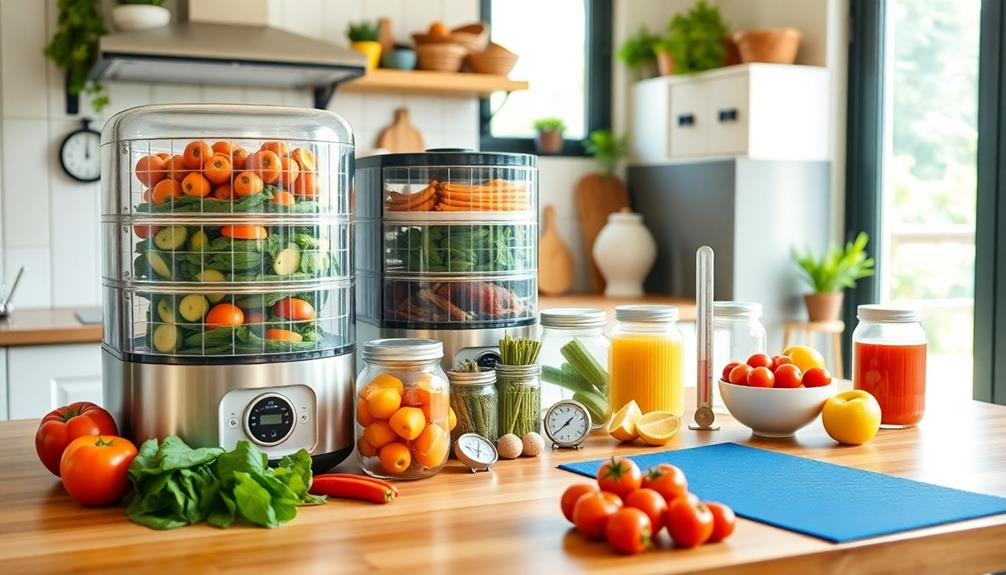
When it comes to raw food preservation, mastering dehydration techniques can greatly extend the shelf life of your ingredients while retaining their nutritional value. Investing in high-quality dehydrators, like the Excalibur, guarantees even heat distribution and effective drying. The 9-tray model is particularly efficient for larger batches, making it a favorite for serious home preservers.
Additionally, utilizing eco-friendly practices, such as using locally sourced ingredients, can further enhance the sustainability of your food preservation efforts, promoting a healthier environment through eco-conscious practices.
Commercial dehydrators are designed for quieter and more accurate performance, which is a bonus if you plan to use them regularly. Proper dehydration methods help maintain food quality and nutrients, allowing you to enjoy the health benefits of your dried foods.
To enhance your drying process, consider using external timers with your dehydrator. This gives you better control over drying times and prevents over-drying, which can compromise food quality.
If you're part of the raw food community, look into Sedona dehydrators, known for their BPA-free options and impressive warranties ranging from 5 to 10 years. Such features reflect their durability and reliability, making them a solid choice for preserving your raw ingredients effectively.
Avoiding Cross-Contamination

Preventing cross-contamination is essential for keeping your raw food preparation safe and healthy. Raw meat can harbor harmful bacteria, so it's important to take specific steps to minimize risks. Here are three key practices to follow:
- Use Separate Utensils and Cutting Boards: Always designate separate utensils and cutting boards for raw meat and cooked foods. This prevents any harmful bacteria from raw meat transferring to ready-to-eat items.
- Clean Surfaces Immediately: After handling raw meat, clean all surfaces and tools with hot, soapy water. This step is necessary to eliminate any lingering bacteria like Salmonella and Campylobacter.
- Store Meat Properly: Store raw meat on the bottom shelf of your refrigerator. This way, you'll prevent juices from dripping onto other foods, reducing the risk of contamination.
Additionally, always wash your hands thoroughly with soap and water after handling raw meat.
Avoid placing cooked meat on surfaces that previously held raw meat without proper cleaning. By following these guidelines, you can greatly reduce the chances of cross-contamination in your kitchen.
Growing Your Own Ingredients
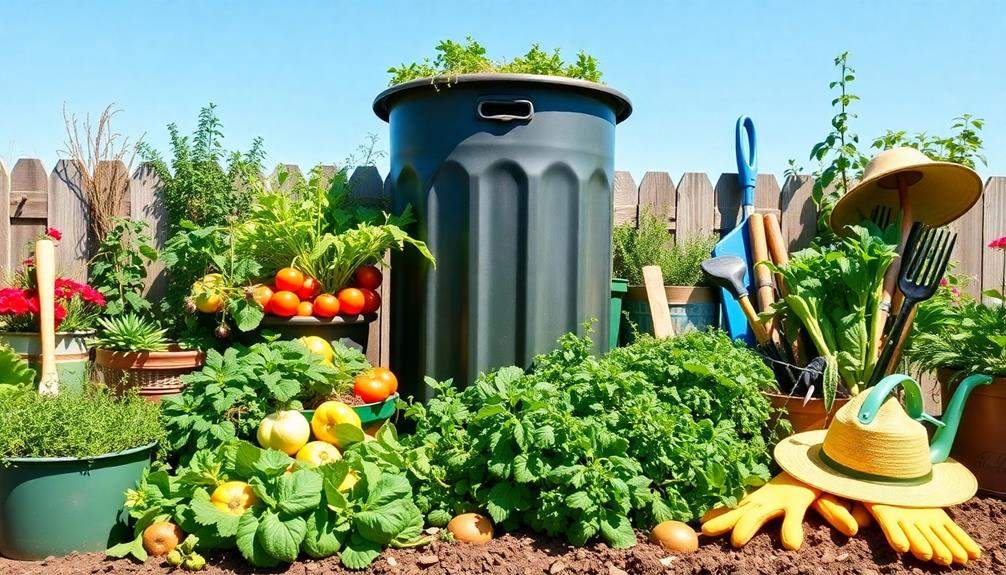
Growing your own ingredients at home not only enhances your raw food diet but also connects you with the fresh flavors and nutrients of your plants. Incorporating essential oils for health into your culinary creations can further elevate your dishes.
One of the easiest and most rewarding ways to start is by growing microgreens. These tiny, nutrient-dense greens, like kale, broccoli, radish, and peas, can thrive in small spaces and require minimal equipment.
Consider investing in a simple home growing kit from providers like The Micro Farmers. They make it easy to cultivate your microgreens right on your kitchen counter.
If you're interested in sprouting, you can soak dormant seeds, nuts, legumes, or grains in water. This technique typically takes just 3 to 5 days to yield nutrient-packed sprouts.
For successful sprouting, all you need are jars with lids and stands to guarantee proper rinsing and airflow.
Make sure to source your organic, non-GMO sprouting seeds from reputable suppliers like West Coast Seeds to assure high germination rates and ethical practices.
Frequently Asked Questions
What Are the 5 Most Important Food Safety Guidelines?
To guarantee food safety, always wash your hands and surfaces, store raw meat properly, use separate utensils, cook meat thoroughly, and regularly clean pet food bowls. These practices help prevent harmful bacteria and contamination.
What Are the 5 C's in Food Safety?
Have you ever wondered how to keep your food safe? The 5 C's in food safety are Clean, Cook, Chill, Combat Cross-Contamination, and Consume. Each step's essential in preventing foodborne illnesses and ensuring health.
What Is the Food Safety Procedure for Raw Meat?
To guarantee food safety with raw meat, keep it separate from other groceries, use dedicated utensils, clean surfaces thoroughly, store it properly, and always cook it to at least 75°C to kill harmful bacteria.
What Are the Safe Handling Instructions for Raw Meat?
Think of raw meat like a ticking time bomb. You've got to use separate utensils, clean surfaces immediately, store it securely at the right temperatures, and wash your hands after handling to prevent dangerous bacteria.
Conclusion
By prioritizing raw food safety, you're not just cooking; you're starting on a culinary adventure, much like a chef in a Michelin-starred restaurant. Equip yourself with the right tools, practice safe handling, and source quality ingredients to create dishes that are not only delicious but also safe. Remember, even the best recipes can fall flat without proper care. So, roll up your sleeves, embrace the journey, and let your kitchen become a haven of raw food mastery!

